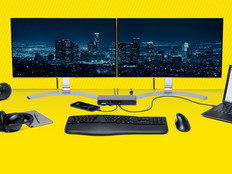Product Review: Wyse E01 Zero Client
Looking for an alternative to full-blown virtualized desktops? Wyse Technology’s E01 zero clients in combination with Microsoft’s MultiPoint Server is one solution. Rather than using a centralized server and Ethernet or Wi-Fi networking to drive the desktop experience, MultiPoint Server can turn three or four networked PCs into workstations for a room full of training students. The Wyse E01 clients link to PCs via a USB connection, providing each user with a Windows desktop.
End-User Advantages
The “zero” in zero client could be describing the size of the E01: The client measures less than an inch high, 5.2 inches wide and 3.4 inches deep. It weighs about 1 pound, so it can be mounted easily on a monitor, leaving no footprint at all on the desktop.
The E01 comes with VGA video and USB connections for a keyboard and a mouse. There are a total of four USB ports, so students can connect other USB devices as well, including thumb drives. The E01 also includes audio jacks for speakers or earphones and a microphone for multimedia applications.
While the E01 connects via USB, the E01 clients can be up to 15 feet away from the MultiPoint server. Depending on the computing capacity of the server, between four and 10 clients can be configured per server. Each user gets a Windows 7 desktop experience, with an individual login.
Another benefit of the E01 client is MultiPoint Server’s “Disconnect” feature. Users don’t have to log off from their work to leave a client; they can pause their work, and their session is disconnected from the client to make it available for someone else. When the student returns to that or another client, they can reconnect their session and resume where they were. Instructors can disconnect students who leave their clients without logging out, preserving the staffer’s work while making the workstation available for someone else.
Why It Works for IT
The biggest advantage of the E01 is its low cost, in terms of both initial purchase and total cost of ownership. The client is priced at $99.99 per unit, and its solid-state design and low power consumption mean low maintenance and operational costs.
Because the E01 uses USB cables to connect to the server instead of Ethernet connections or Wi-Fi, it greatly reduces training room network infrastructure requirements. It also greatly reduces power demand in comparison with a desktop PC. The E01’s average power usage is less than 3 watts, so 10 E01 devices use about the same amount of power as one notebook computer.
The E01 also reduces the administrative burden considerably. The device is plug-and-play — no additional setup is required once the server is configured. And the installation process for MultiPoint Server is designed for nontechnical users, so an instructor could configure and manage the server and users’ accounts in the classroom.
Software needs to be installed only once per server for it to be available to every user. And security is also centralized: MultiPoint Server can automatically install Windows updates and patches.
Disadvantages
The simplicity of the E01 can also be a drawback. The USB-based tethering to the MultiPoint server may mean you’ll have to reconfigure workspace to cluster workstations around each host. Also, if you have more than 10 simultaneous users on E01 clients, you’ll need more than one server, which can run an extra $2,000 or so for an adequate 64-bit machine. While you can have multiple servers set up with the simple local-user configuration, user administration becomes more complicated if you want to administer users across multiple MultiPoint servers.







